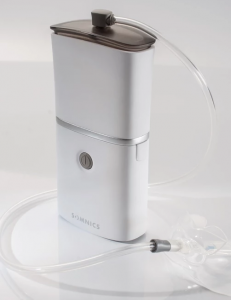Is there danger lurking in your bedroom? Instead of the welcome relief, you would expect when climbing into bed after a long day, do you dread putting your head on the pillow for fear of gasping for air during sleep? Do you have difficulty staying asleep or, worst of all, keeping your partner awake due to your loud snoring?
If this sounds like you, then it is time to get assessed for sleep apnea by your doctor or a certified sleep physician.
SLEEP APNEA EXPLAINED
People with mild sleep apnea experience sporadic pauses in their breathing, lasting ten seconds or more. These disturbances are typically very brief, and the person experiencing them may not even know their sleep is being interrupted. However, if your sleep cycle is disrupted to the extent that you are not reaching the expected deep and restful sleep phases, you could suffer from obstructive sleep apnea (referred to as OSA).
- Symptoms
Symptoms include waking up with a dry mouth, your sleeping partner reporting that you stop breathing during sleep, a morning headache, experiencing excessive daytime sleepiness, irritability, and difficulty paying attention during waking hours.
- Physical Effects
The physical effects of OSA are that your soft tissues collapse into your upper airways, causing a full or partial airflow blockage.
OBTAINING A SLEEP ASSESSMENT
Whilst you may feel able to cope with your symptoms, there are definite dangers to leaving your condition uncontrolled. A sleep assessment will establish your AHI (Apnea-Hypopnea Index). This is a measure of the severity of your sleep apnea.
- Apnea-Hypopnea Index
If you have an AHI of 10, you experience an average of ten collapses per hour while sleeping. It is usual for adults to have up to four apnea events per hour of sleep, but this can vary during the night depending on your position, weight, alcohol use, etc. The AHI Scale looks like this:
- Normal – Under 5
- Mild sleep apnea – 5-15
- Moderate sleep apnea – 15-30
- Severe sleep apnea – 30 or more
Diagnosis
OSA is diagnosed by Doctors using a sleep test that measures your brain function and cardio-respiratory activity during sleep. These tests are efficiently conducted at home or in a sleep lab.
SNORING AND SLEEP APNEA
The connection between snoring and sleep apnea is tenuous. Snoring is the sound created by resistance in your airway. Loud snoring does not mean you have sleep apnea. Conversely, you may have sleep apnea and not be a snorer. If any of the symptoms mentioned above accompanies your snoring, it would be a good idea to seek an assessment for OSA.
DANGEROUS HEALTH ISSUES RELATED TO SLEEP APNEA
Sleep apnea has links, like the tendrils on a vine, to health issues such as heart attacks, strokes, type 2 diabetes and even a shortened lifespan.
- One of the common denominators in sleep apnea sufferers is obesity. Losing weight is a crucial factor in treating or preventing sleep apnea. However, not everyone who suffers from sleep apnea is overweight.
- Studies have shown that sleep apnea can increase blood sugar levels and, therefore, its association with a higher risk of diabetes.
- A sudden drop in oxygen levels during OSA increases blood pressure and strains the cardiovascular system. The risk of heart disease is increased in many people with obstructive sleep apnea as they may develop high blood pressure. OSA can also increase the risk of arrhythmias, which can dangerously lower blood pressure.
- Those with OSA should be concerned if they are on certain medications or need to undergo a general anesthetic, as either of these situations could adversely affect existing breathing problems. When discussing possible surgery with your doctor, always mention that you suffer from OSA.
CAN SLEEP APNEA KILL YOU?
It is rare for sleep apnea to kill you, but if left untreated, it could have long-term consequences due to accumulated damage. A recent Johns Hopkins study examined what happens to metabolism at night when sleep apnea patients are untreated. The study found that the resulting apnea caused a spike in blood sugar, heart rate, blood pressure and stress hormones. It is essential to research the contributing factors of your sleep apnea to prevent your condition from worsening and allowing your doctor to design an ongoing treatment program for you. Ageing is an unavoidable factor, but weight gain, heart health and muscle tone of your upper airway can be managed with appropriate treatment.
TREATMENT METHODS
CPAP Machine
A traditional and effective treatment for sleep apnea is a breathing device called a CPAP, or continuous positive airway pressure machine. A CPAP machine conducts humidified air through the nose, creating air pressure to keep your throat open while you sleep. The difficulty with the CPAP machine is that it requires you to wear a cumbersome, uncomfortable mask over your nose while you sleep, kept in place with straps around your head and neck. Tubing from the mask connects to the rather noisy CPAP device.
The iNAP System
With a desire to find a more satisfactory solution for OSA sufferers and the physicians who treat them, the founder of Somnics Inc developed the revolutionary iNAP sleep therapy system.
- The exciting news is that the iNAP system works without a facial mask and uses a discreet soft oral interface and a pocket-sized, battery-powered console.
- With iNAP you are guaranteed a comfortable night’s sleep as a gentle vacuum is created within your oral cavity to stabilize your tongue and soft tissues. iNAP’s intermittent negative airway pressure effectively eliminates apnea by keeping your airway open, allowing you to breathe naturally and sleep peacefully.
- During the first medical assessment after acquiring and using your iNAP device, your doctor may need to modify your device settings to improve your response to the therapy.
The iNAP SYSTEM – A NEW ERA IN SLEEP APNEA TREATMENT
HOW TO ACQUIRE
- Once you are diagnosed as an appropriate candidate for iNAP by your doctor, he will prescribe the iNAP device. You will then be able to place an order from our online store and easily be able to assemble your device by following the instructions provided in your pack.
- To accommodate your needs, you may own an iNAP device or opt for a membership.
MAINTAINING YOUR iNAP
Maintaining your device is quick and easy.
- Cleaning
A new drypad is required daily, and the oral interface, tubing and saliva cup require rinsing. Weekly sanitizing is advised.
- Battery Charging
The battery life can last up to six days, depending on your habits and hours of usage. The device is supplied with a micro-USB charger, the same type that you may use for your cell phone.
TRAVELLING WITH YOUR iNAP
Your active lifestyle will be able to continue if you are an iNAP user. The device is small and easy to carry. From travelling far and wide to a weekend of camping, you will still be able to continue with your sleep apnea treatment.
TRACKING YOUR iNAP USAGE
By pairing your device and an optional oximeter to your smartphone, you can track your usage and take control of your treatment data. Ensure your oximeter is compatible with our iNap device. It is as simple as downloading the iNAP Lab+app from the App Store or Google Play. Your treatment time, sealing percentage and oxygen desaturation index (ODI) are displayed by the day, week and month. This is powerful information and a great aid to the success of your treatment.
HEALTH REIMBURSEMENT FOR YOUR iNAP
iNAP is eligible for coverage under HSA/FSA employer plans, and Somnics Health Reimbursement is available to answer any of your queries and guide you in applying for this cover.
FIND OUT MORE ABOUT iNAP
iNap has hundreds and hundreds of users, and successful treatment of obstructive sleep apnea is directly linked to these patients’ high motivation to make the therapy work for them. If you feel the same as these users, then iNAP may be an excellent option for you.
Find out more by visiting our website: https://www.inapsleep.online/
You can follow us on Facebook, Twitter, Linkedin and Youtube
Email us at: contact.us@somnics.com
Or book a ten-minute appointment with a Somnics representative by clicking here.




